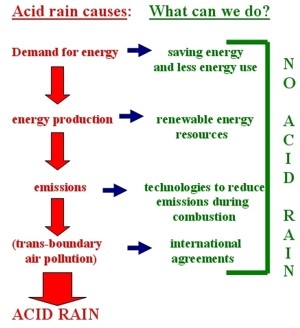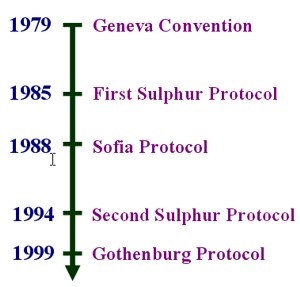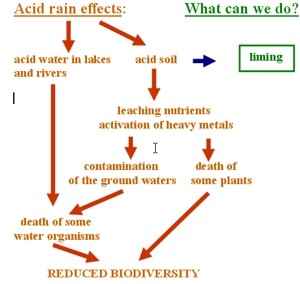 > English > Climate Encyclopaedia > Climate in Cities > more > 3. Acid Rain > - What can we do?
> English > Climate Encyclopaedia > Climate in Cities > more > 3. Acid Rain > - What can we do?
|
Urban ClimateRead more |
What can we do to counteract acid rain?All of us can do something to limit the formation of acid rain or help reduce its effects. These actions vary from international agreements, through soil and water liming, to energy saving.
|
Two directionsEfforts undertaken to counteract acid rain can be divided into two groups:
|
Better technologyMany new technologies have been developed for industry which reduce the emissions of pollutants into the air. These can be applied before, during or after combustion. Examples of pre-combustion sulphur control technology (removing sulphur before burning) include coal scrubbing and oil desulphurisation. One of the post-combustion sulphur controls (removing sulphur after burning) is Flue Gas Desulfurisation (FGD). This process is, however, rather expensive. The cost of removing one kilogram of sulphur is between three and six US dollars (between three and five Euros). Figure 2. shows how a dry scrubbing system works.
|
|
|
Nitrogen oxide emissions from cars can be reduced by fitting catalytic converters. These convert the nitrogen oxides into harmless nitrogen gas. Figures 3. and 4. explain how a catalytic converter works. |
Nitrogen oxides can also be removed from the flue gases of power stations. One method involves mixing the flue gases with ammonia which converts the nitrogen oxides to nitrogen gas and water. This process can be used on both existing and new power stations and can reduce emissions by up to 90%.
|
|
International co-operationConcern in the late 1970's led to international efforts to identify the causes and effects of long-range (transboundary) transport of air pollutants. During the 1980's much research was conducted in Europe and North America. International legislation during the 1980's and 1990's has led to huge reductions in SO2 emissions in many countries but reductions in NOx emissions have, unfortunately, been much less.
|
|
In 1979, the United Nations Economic Commission for Europe (UNECE) implemented the Convention on Long-Range Transboundary Pollution (the so-called Geneva Convention). In 1985, in Helsinki, most UNECE members adopted the Protocol on the Reduction of Sulphur Emissions, agreeing to reduce SO2 emissions by 30% (from 1980 levels) by 1993. This was called the 30% club. All of the countries that signed the Protocol achieved this reduction. Many other countries have now also met these targets.
|
|
The Sofia Protocol for reducing NOx emissions was adopted in 1988. The protocol is based on 1987 levels. Many countries are unlikely to meet these targets, due to increases in road traffic and despite European Union legislation requiring cars built after 1993 to be fitted with a catalytic converter. In June 1994, a number of European countries signed the Second Protocol for sulphur. Its main objective was to reduce acidifying emissions to a level at which critical loads are not exceeded, i.e. to reduce sulphur emissions by 70-80% by the year 2000 (against 1980 levels). Eastern European countries generally have a lower target of 40-50% (against 1980 levels). The most recent UNECE Convention on Long Range Transboundary Air Pollution was signed by 27 countries in December 1999. The Gothenburg Protocol, designed to Abate Acidification, Eutrophication and Ground-level Ozone aims to cut emissions of four pollutants: SO2, NOx, VOC's and NH3, by setting country-by-country emission ceilings to be achieved by the year 2010.
|
Neutralising the effects
|
|
Once acid rain forms, all we can do is neutralise its effects. Action has to be taken quickly to have any effect at all and the most commonly used method is liming. This is described below.
|
Natural and artificial buffersThe acidity of a water body is greatly influenced by the amount of limestone in the surrounding rock formations. River beds and lake beds formed from limestone rocks are partially dissolved by the acidic water and this neutralises the acid. At present the main way of artificially reversing acidification in freshwaters is liming the water body or its surrounding catchment by adding sodium hydroxide (NaOH) or slaked lime (calcium hydroxide Ca(OH)2). Liming increases the pH of the water, causing aluminum and other metals to come out of solution and fall to the bottom of the lake as metal rich sediments. This improves the conditions for surface living organisms but causes toxicity problems for organisms living on the lake bed. Acidified lakes in Sweden, the USA and Canada have all been restored in the short term by liming. Liming on a large scale, however, is expensive. Liming provides only a temporary solution, it's far better to attack the source of the problem by reducing emissions of the acidifying pollutants, sulphur dioxide and the nitrogen oxides.
|
|
Related pages: Learn more about the origin of acid rain and double role of ammonia in:
|
About this page:author: Anita Bokwa - Jagiellonian University, Cracow, Poland
|






